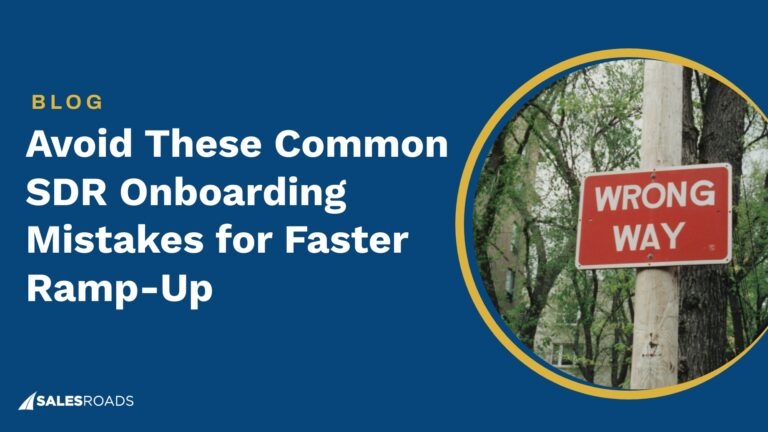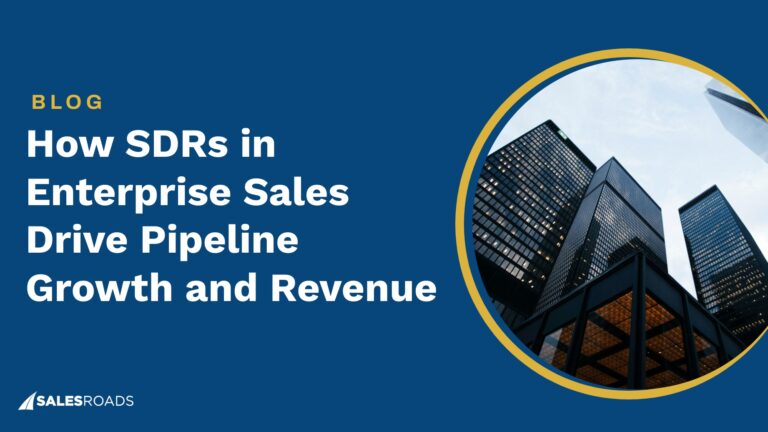SDR lead generation helps businesses identify prospects that require the least amount of time and effort to convert. This process increases the sales pipeline efficiency without overworking account executives.
Lead Generation Definition
Sales funnels begin with lead generation, which is the process of attracting potential customers to a product or service. Businesses can benefit from lead generation by:
- Filling the pipeline with qualified leads: Lead generation replaces churn by identifying prospects who’ll benefit the most from your offerings.
- Speeding up the sales cycle: A well-executed lead generation strategy efficiently moves prospects along the buyer’s journey, which speeds up the closing process.
- Increasing brand awareness: Many lead generation strategies are designed to increase your audience reach and establish your brand as an industry and subject-matter expert.
How Sales Development Representatives Implement Lead Generation
The primary role of sales development representatives (SDRs) is to unburden salespeople by taking over lead qualification tasks. They bridge the gap between sales and marketing, ensuring that the pipeline has a steady conversion stream while reducing missed opportunities.
There are two types of SDR lead generation: inbound and outbound.
| Comparison | Inbound SDR | Outbound SDR |
|---|---|---|
| Prospects | Warm leads | Cold outreach |
| Main Task | Qualify inbound leads | Engage outbound leads for appointments |
| Lead Generation | Responding to marketing-generated leads (e.g., webinars, content downloads, contact forms) | Identifying new target companies and contacts, researching potential clients’ needs and pain points |
| Lead Qualification | Assessing lead quality based on predetermined criteria (e.g., BANT – Budget, Authority, Need, Timeline) | Pre-qualifying prospects through initial contact, uncovering potential opportunities |
| Outreach Channels | Primarily email and phone calls, but may also include social media and chat interactions | Primarily email, phone calls, and social media (e.g., LinkedIn), occasionally events or direct mail |
| Follow-up | Tracking and nurturing inbound leads through the sales funnel, ensuring timely follow-ups | Consistent follow-up with prospects, customizing messaging based on prospect’s industry, role, or pain points |
| CRM Management | Logging and maintaining lead information in CRM, updating lead status and tracking interactions | Adding new contacts and accounts in CRM, documenting outreach efforts and updating prospect information |
| Collaboration | Collaborating with marketing to improve lead generation efforts and qualify leads more effectively | Collaborating with sales to develop target account lists, align messaging, and ensure a smooth handoff of qualified leads |
| KPIs & Metrics | Number of qualified leads, lead-to-opportunity conversion rate, response time | Number of outbound contacts made, number of appointments set, opportunities created, conversion rates |
Both inbound and outbound SDRs share the goal of identifying and qualifying leads to pass on to the sales team. However, the methods they use to generate and engage those leads differ, as do some of their specific tasks and responsibilities.
Inbound Lead Generation
Inbound lead generation refers to strategies that generate attention to your brand and offerings. SDRs are commonly deployed at the end of this process to qualify inbound leads before passing them onto the sales team.
A lead qualification process determines if an MQL is ready to become a sales-qualified lead (SQL). The definition of an SQL varies, but it usually refers to a prospect that fits the company’s ideal customer profile.
Inbound SDRs may also be responsible for generating, not just qualifying, MQLs. Inbound SDRs can generate MQLs by targeting leads that have not yet requested contact from a sales team but that fit the company ICP. Emailing a list of webinar registrants is an example of this technique. Common outreach tactics for generating MQLs include:
- Email marketing: This technique uses email as a marketing channel to raise awareness for an offering and inform potential customers about promotions and new products.
- Content marketing: Creating and sharing valuable content, such as blog posts, whitepapers, or infographics, to attract and engage target audiences. This approach helps establish thought leadership and brand credibility, ultimately generating leads.
- Social media marketing: Utilizing platforms like LinkedIn, Twitter, and Facebook to share content, engage with potential customers, and promote your brand, products, or services.
- Webinars and online events: Hosting webinars or participating in online events to educate and engage with potential customers, and to generate leads through registrations.
Inbound SDRs play a crucial role in processing and nurturing leads generated through these various inbound marketing tactics. They are responsible for qualifying MQLs and converting them into SQLs, ensuring that the sales team can focus on closing deals with high-quality prospects.
Outbound Lead Generation:
Unlike inbound lead generation, wherein potential customers approach your brand, outbound lead gen requires engaging prospects using the following techniques:
- Cold calling: This tactic involves calling prospects that belong to a particular demographic and introducing them to your brand and offering. It’s a common lead qualification strategy that aims to gather prospects’ data instead of closing deals.
- Cold emailing: This process is similar to cold calling, but instead of phones, it uses email as a channel to engage unknowing prospects.
Outbound lead generation strategies are often challenging to implement because they elicit a wide range of responses. Fewer prospects answer cold calls or emails, while the rest are likely to dismiss them. This is why having experienced and trained SDRs is crucial to get the best possible outcomes.
In some companies, outbound and inbound SDRs are merged into one role, as they have overlapping responsibilities.
Sales Development Representative Metrics
Tracking SDR metrics enables evaluating performance objectively. You can use the following indicators to assess the effectiveness of both inbound and outbound SDR lead generation:
1. Response Rates & Outcomes
This metric is used to evaluate the effectiveness of both inbound and outbound SDRs’ outreach efforts. It reveals how well SDRs are able to engage with leads and move them through the sales funnel.
Response rates and outcomes can be categorized as:
- Positive response
- Negative response
- Neutral response
- No response
- Follow-up scheduled
How to track:
Most CRM tools have features that allow SDRs to log the responses received from their outreach efforts, such as emails or phone calls. If your SDRs are not using CRM systems, they can manually track these numbers.
2. Lead-to-Opportunity Conversion Rate
This metric measures the percentage of leads that are converted into opportunities by SDRs, indicating their ability to qualify leads effectively and transition them to the next stage in the sales process.
How to track:
Track the number of leads that become opportunities in your CRM system, and calculate the conversion rate by dividing the number of opportunities by the total number of leads.
3. Opportunities Created
This metric highlights the number of potential sales opportunities generated by SDRs, which can be used to evaluate their overall performance and impact on the sales pipeline.
How to track:
Track the number of opportunities created by each SDR in your CRM system. Compare these numbers across team members and against individual or team goals.
4. Time to First Contact
This metric measures the speed at which SDRs reach out to new leads, indicating their responsiveness and efficiency. Faster first contact times can lead to higher engagement rates and better lead qualification results.
How to track:
Track the time between when a lead is added to the CRM system and when the SDR first contacts them. Calculate the average time to first contact for each SDR and compare it with team benchmarks or goals.
5. Appointment Show Rate
This metric measures the percentage of scheduled appointments that result in a successful meeting, indicating the quality of appointments set by SDRs and their ability to engage prospects effectively.
How to track:
Track the number of scheduled appointments and the number of successful meetings. Calculate the show rate by dividing the number of successful meetings by the total number of scheduled appointments.
6. Lead Nurturing Effectiveness
This metric evaluates the ability of SDRs to maintain and develop relationships with leads over time, ultimately resulting in higher lead-to-opportunity conversion rates.
How to track:
Monitor the engagement levels of nurtured leads, such as email open rates, click-through rates, and responses to follow-up communications. Compare these metrics with benchmarks or goals to assess the effectiveness of lead nurturing efforts.
7. KPI Achievement Rate
This metric measures the extent to which SDRs are meeting or exceeding their key performance indicators (KPIs), providing insight into individual and team performance.
How to track:
Monitor the achievement of each SDR’s KPIs, such as the number of calls made, emails sent, appointments set, or opportunities created. Calculate the achievement rate by dividing the actual results by the target values, and compare these rates across team members and against organizational goals.
Inbound SDR Metrics
The following metrics can be used to measure the effectiveness of lead generation activities performed by inbound SDRs.
1. Inbound Lead Response Time
This metric measures how quickly inbound SDRs respond to new leads, which is crucial for effective lead engagement and higher conversion rates.
How to track: Monitor the time between when a lead is generated (e.g., form submission or content download) and when the SDR first contacts the lead. Calculate the average response time for each SDR and compare it with team benchmarks or goals.
2. Lead Source Effectiveness
This metric evaluates the quality and quantity of leads generated by different marketing channels, helping to identify which sources are most successful in producing high-quality leads for inbound SDRs.
How to track: Categorize leads by their source (e.g., organic search, email marketing, social media) and track the number of leads generated from each source. Calculate the lead-to-opportunity conversion rate for each source to determine their effectiveness in generating high-quality leads.
3. Inbound Lead Qualification Rate
This metric measures the percentage of inbound leads that are qualified by SDRs, indicating their effectiveness in identifying high-potential leads and moving them through the sales funnel.
How to track: Track the number of inbound leads that are qualified and moved to the next stage in the sales process. Calculate the lead qualification rate by dividing the number of qualified leads by the total number of inbound leads.
4. MQL-to-SQL Conversion Rate
This metric evaluates the ability of inbound SDRs to convert Marketing Qualified Leads (MQLs) into Sales Qualified Leads (SQLs), which is crucial for maintaining a healthy sales pipeline.
How to track: Monitor the number of MQLs that are converted into SQLs by each inbound SDR. Calculate the conversion rate by dividing the number of SQLs by the total number of MQLs.
5. Content Engagement Metrics
These metrics assess the effectiveness of content marketing efforts in generating and engaging leads for inbound SDRs.
How to track: Monitor content engagement metrics such as page views, time on page, content downloads, and social shares. Compare these metrics with benchmarks or goals to assess the effectiveness of content marketing efforts in generating leads for inbound SDRs.
6. Inbound Lead Follow-up Rate
This metric measures the percentage of inbound leads that receive a timely follow-up from SDRs, which is essential for maintaining engagement and improving lead-to-opportunity conversion rates.
How to track: Track the number of inbound leads that receive a follow-up within a predetermined time frame (e.g., 24 hours). Calculate the follow-up rate by dividing the number of leads that received a timely follow-up by the total number of inbound leads.
7. Inbound Lead Nurturing Effectiveness
This metric evaluates the ability of inbound SDRs to maintain and develop relationships with leads over time, ultimately resulting in higher lead-to-opportunity conversion rates.
How to track: Monitor the engagement levels of nurtured leads, such as email open rates, click-through rates, and responses to follow-up communications. Compare these metrics with benchmarks or goals to assess the effectiveness of lead nurturing efforts by inbound SDRs.
Outbound SDR Metrics
The following metrics can be used to measure the effectiveness of lead generation activities performed by outbound SDRs.
1. Outbound Outreach Volume
This metric measures the number of outreach attempts made by outbound SDRs, such as phone calls, emails, and social media messages. High outreach volume is essential for generating new leads and opportunities.
How to track: Monitor the number of outreach attempts made by each outbound SDR. Compare these numbers with individual or team goals and evaluate trends over time.
2. Outbound Lead Contact Rate
This metric measures the percentage of outbound outreach attempts that result in a meaningful conversation with a potential lead. Higher contact rates indicate more effective outreach efforts.
How to track: Track the number of meaningful conversations resulting from outbound outreach attempts. Calculate the contact rate by dividing the number of successful conversations by the total number of outreach attempts.
3. Account Penetration Rate
This metric evaluates the ability of outbound SDRs to engage with multiple contacts within target accounts, which is crucial for effectively navigating complex organizations and finding potential opportunities.
How to track: Monitor the number of contacts engaged within target accounts and calculate the penetration rate by dividing the number of engaged contacts by the total number of contacts in the account.
4. Outbound Opportunity Creation Rate
This metric measures the percentage of outbound outreach attempts that result in the creation of a sales opportunity, indicating the effectiveness of outbound SDRs in uncovering potential deals.
How to track: Track the number of opportunities created from outbound outreach attempts. Calculate the opportunity creation rate by dividing the number of opportunities created by the total number of outreach attempts.
5. Outbound Lead-to-Opportunity Conversion Rate
This metric evaluates the ability of outbound SDRs to convert leads into opportunities, which is essential for maintaining a healthy sales pipeline.
How to track: Monitor the number of outbound leads that are converted into opportunities. Calculate the conversion rate by dividing the number of opportunities by the total number of outbound leads.
6. Target Account Coverage
This metric assesses the effectiveness of outbound SDRs in reaching out to and engaging with their assigned target accounts, which is crucial for generating new opportunities.
How to track: Monitor the number of target accounts that each outbound SDR has engaged with, either through a meaningful conversation or an outreach attempt that has received a response. Compare these numbers with the total number of assigned target accounts to evaluate coverage.
7. Outbound Sales Cycle Length
This metric measures the average time it takes for outbound SDRs to move leads from initial outreach to opportunity creation, providing insight into their efficiency and effectiveness in the sales process.
How to track: Track the time between initial outreach and opportunity creation for each outbound lead. Calculate the average sales cycle length for each outbound SDR and compare it with team benchmarks or goals.
FAQ
What is the difference between inbound and outbound SDRs?
Inbound SDRs focus on qualifying and nurturing leads that have already expressed interest in the company’s products or services, often through marketing efforts. Outbound SDRs, on the other hand, proactively engage with potential leads through cold outreach, such as phone calls, emails, and social media messages, to generate new sales opportunities.
How can I measure the success of inbound SDRs?
Key metrics for evaluating inbound SDRs include inbound lead response time, inbound lead qualification rate, inbound lead-to-opportunity conversion rate, inbound opportunity creation rate, and the overall volume of qualified inbound leads generated.
How can I measure the success of outbound SDRs?
Some key metrics for evaluating outbound SDRs include outbound outreach volume, outbound lead contact rate, account penetration rate, outbound opportunity creation rate, and outbound lead-to-opportunity conversion rate.
What is the role of lead qualification in SDRs’ tasks?
Lead qualification is the process of determining whether a lead has the potential to become a customer. Both inbound and outbound SDRs are responsible for qualifying leads based on predetermined criteria, ensuring that only high-quality leads are passed on to the sales team.
How can CRM systems help track SDR performance?
CRM systems can help track SDR performance by logging outreach activities, lead statuses, responses, opportunities created, and other relevant data. These systems can also generate reports and analytics that provide insights into individual and team performance, helping to identify areas for improvement.
Are there any specific metrics for evaluating the effectiveness of SDRs’ content engagement efforts?
Yes, content engagement metrics such as page views, time on page, content downloads, and social shares can help assess the effectiveness of content marketing efforts in generating and engaging leads for both inbound and outbound SDRs.
Bottom Line
SDR lead generation can speed up the sales cycle by engaging prospects with the highest conversion potential, allowing businesses to boost revenue and scale.











